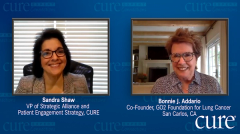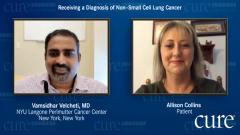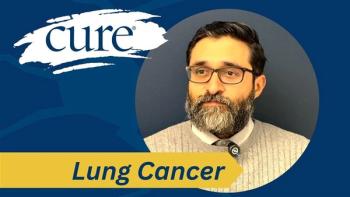
Treatment Targets in Non-Small Cell Lung Cancer
Treating patients with lung cancer by identifying specific biomarkers to use the correct combination therapy and what it means for a biomarker to be actionable.
Episodes in this series

Sandra Shaw: With biomarkers, as you said, it’s like winning the lottery. What are the actionable biomarkers for non-small cell lung cancer?
Bonnie Addario: There are 10: EGFR mutation and ALK being the biggest. ROS1 is like 1% of lung cancer. And then there’s MET and RET and NTRK and others that are just coming about, and we don’t know how many people actually have those markers—that’s how new they are. But that’s why all of them have to be tested for upon diagnosis.
Sandra Shaw: Are there any other promising biomarkers on the horizon?
Bonnie Addario: Let’s just take the EGFR mutation. There are quite a few submutations that you need to be tested for, like exon 19. And so you have this patient who just has an EGFR marker, no submutations, but then somebody over here that has the EGFR mutation with some submutations. Those must be tested. It’s a moving target, but that’s the most amazing and wonderful news: if everyone participates and if we get everyone tested.
Sandra Shaw: And they get comprehensive testing, right?
Bonnie Addario: Yes, they get tested for everything.
Sandra Shaw: That provides a tremendous hope for patients with lung cancer. It’s great to hear that we’ve identified all these mutations if there are more promising ones on the horizon. But what does it mean if a patient with non-small cell lung cancer doesn’t have a biomarker? How does the doctor choose the right treatment for that patient?
Bonnie Addario: I want to say this to any patients who might be watching: no marker today, but down the road, maybe. You might not have one early on, but you have something as your cancer progresses. Chemotherapy is still a really good drug. I don’t want patients to be afraid of it or scared of it. There are many movies on TV and things we’ve seen all our lives. Chemotherapy is a good drug. Now they’re partnering chemotherapy with some of these other drugs that are working better than they ever imagined. For the most part, there’s something out there for everybody. If it’s not chemotherapy or another drug, it’s a clinical trial. Clinical trials today aren’t taking four years. They’re moving faster. The FDA is moving faster. Everybody is at the brink of having lung cancer turning a really big corner. These are exciting times.
Sandra Shaw: That’s exciting. It’s great to hear the positive news for patients with lung cancer. What happens if a patient with an actionable biomarker doesn’t respond to the targeted therapy? Where do they go from there?
Bonnie Addario: They get retested to see if something was missed early on. That’s why this testing is great. It used to be that biomarker testing took place only in the tissue. From your biopsy itself, they would get a core piece of tissue, and that’s how they knew what your marker was. Now we can do it with blood in short order. The rule of thumb on blood vs tissue—a lot of doctors out there say tissue is always the issue. For the most part, if you get a biomarker test on your tissue, if it’s actionable, it’s going to be there. Sometimes in blood, you’ll take the blood test early because we want to rush to find out what’s going on with the patient because their cancer has already jumped out of being localized. But if it’s in tissue, it’s there. If you get a blood test and they don’t see anything, then back it up with a tissue test.
Sandra Shaw: That’s great information for patients.
Bonnie Addario: And the doctors.
Transcript edited for clarity.








